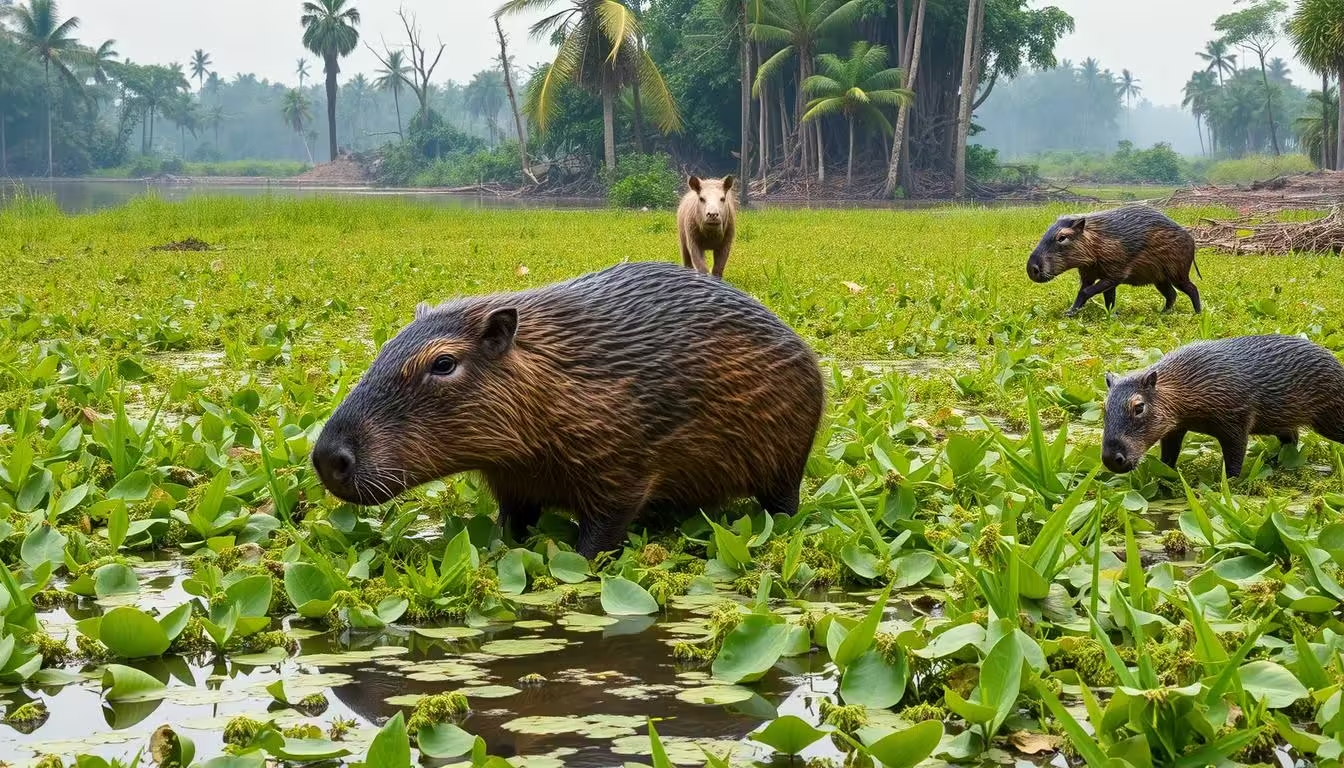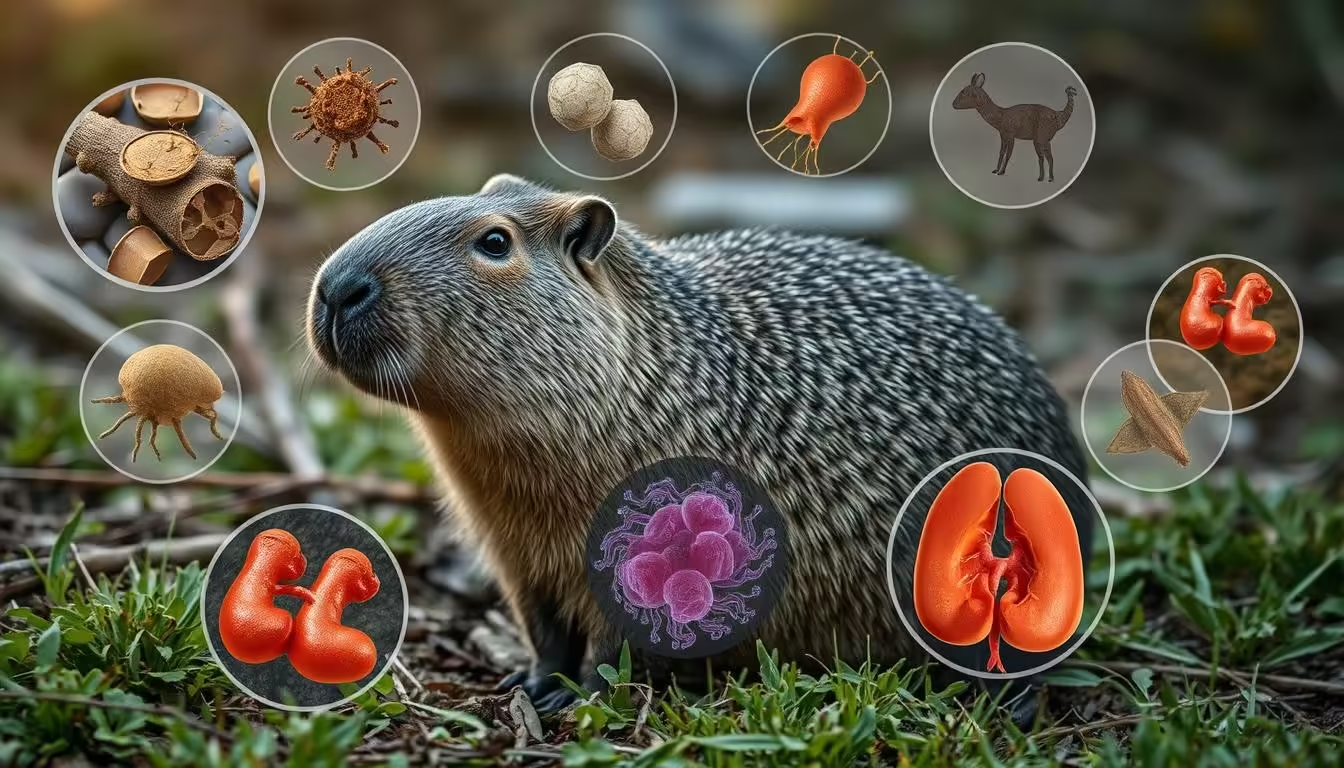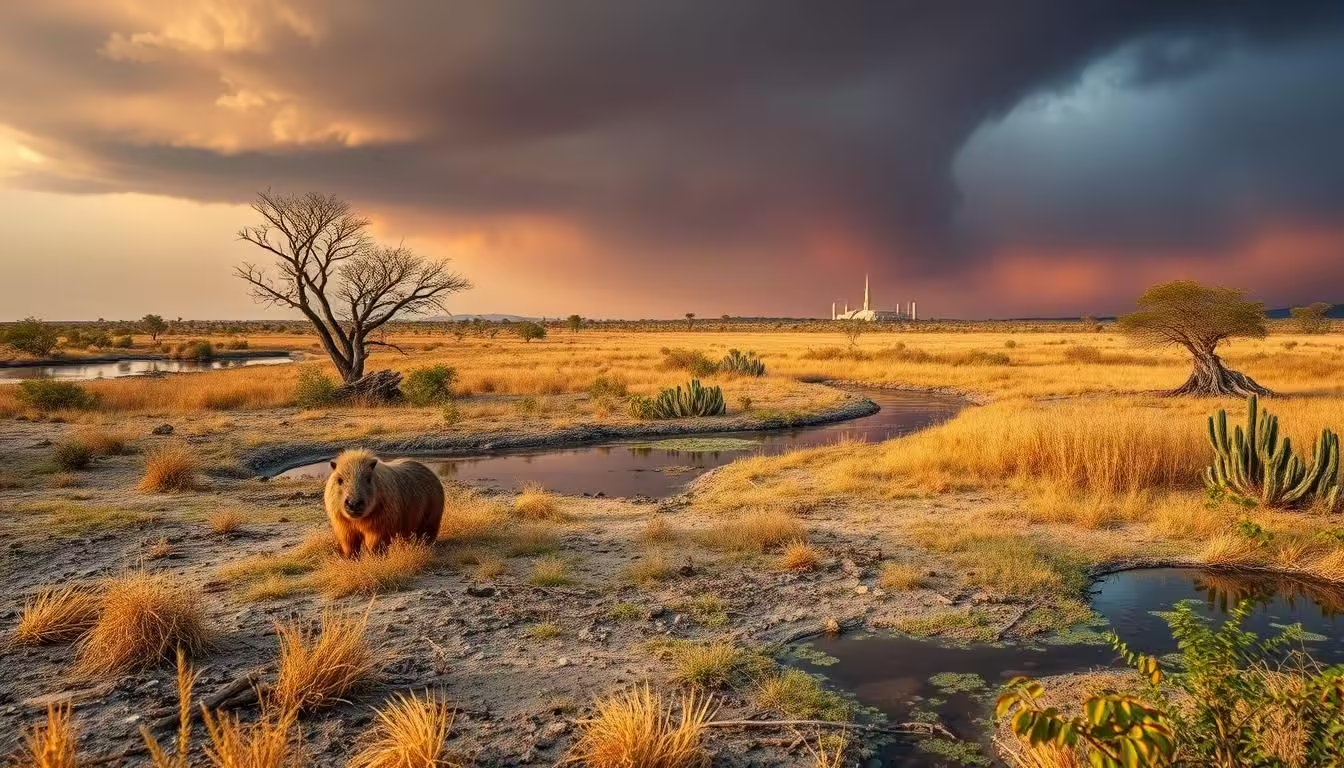Capybaras are under pressure from predators, habitat loss, poaching, and environmental changes. It’s important to understand these threats. This knowledge helps us find ways to save this unique species.
Key Takeaways
- Capybaras are the largest rodents in the world, weighing up to 174 pounds and measuring up to 4.2 feet in length.
- They face a range of threats, including natural predators like jaguars, habitat destruction, illegal poaching, and environmental changes.
- Predation, diseases, and environmental factors can significantly impact the lifespan of capybaras in the wild, with many living less than four years.
- Habitat loss due to deforestation and urban development is a major threat to capybara populations across Central and South America.
- Conservation efforts and local community involvement are crucial for protecting capybaras and ensuring their long-term survival.
Understanding Capybaras: Overview of the World’s Largest Rodent
Capybaras are amazing creatures, known as the world’s largest rodents. They live in wetlands and savannas of Central and South America. Their light brown, shaggy coats and webbed feet help them thrive in water.
Physical Characteristics and Natural Habitat
Capybaras can weigh 77 to 150 pounds when they’re fully grown. They grow up to 4 feet long and 2 feet tall. In the wild, they weigh 40 to 50 kg, but in captivity, they can be heavier, up to 60 kg.
They can run fast on land, up to 35 km per hour. They can also stay underwater for up to 5 minutes. This makes them well-suited to their capybara habitat.
Distribution Across Central and South America
Capybaras live from Panama to northern Argentina. They love wetlands like swamps and riverbanks. They eat a lot of grass, up to 8 pounds a day.
Social Structure and Behavior
- Capybaras live in groups of 5 to 15 adults. But, they can gather in groups of up to 60 during the wet season.
- They become sexually mature between 18 months and two years. They have a 150-day gestation period.
- Mothers have 4 to 6 pups, but it can range from 1 to 8. The pups stay with their mothers for about 16 weeks.
- In the wild, they live 6 to 10 years. But, in captivity, they can live up to 15 years.
Capybaras are fascinating with their capybara social structure and wetland adaptations. Their size and social nature make them interesting to watch in their natural habitats.
Natural Predators and Defense Mechanisms
Capybaras, the world’s largest rodent, face many predators. Jaguars are the main threat, hunting adult capybaras. Young ones are also at risk from caimans, ocelots, harpy eagles, and anacondas.
To fight off these dangers, capybaras have clever ways to defend themselves. They can stay underwater for up to five minutes. Their slightly webbed feet help them swim and dive fast, hiding from threats in the water.
| Capybara Predators | Capybara Defense Mechanisms |
|---|---|
|
|
Thanks to these defense strategies, capybaras can avoid predators. This helps them survive in their homes across Central and South America.
“Capybaras are incredibly adaptable and have developed remarkable strategies to protect themselves from the threats they face in their natural environment.”
Predators, Diseases, and Environmental Threats to Capybara Lifespan
The capybara, the world’s largest rodent, faces many challenges. These include predators, diseases, and environmental threats. Despite living up to 10 years in the wild and 12 in captivity, their lives are often cut short.
Common Diseases Affecting Capybara Population
Capybaras are prone to various diseases. These include parasitic, bacterial, and viral infections. Some common diseases are:
- Leishmaniasis, a parasitic disease spread by sandflies
- Leptospirosis, is a bacterial infection that harms the kidneys and liver
- Trypanosomiasis, is a parasitic infection causing anemia and wasting
Impact on Life Expectancy
In the wild, capybaras can live up to 10 years. However, their average life is about 4 years. This is due to predators, diseases, and environmental stressors.
Prevention and Management Strategies
To protect capybaras, a multi-faceted approach is needed. Conservation efforts, like preserving habitats, are key. Also, stopping illegal hunting and poaching is vital. Veterinary care and disease monitoring can help manage capybara diseases and extend their capybara life expectancy.
Habitat Loss and Deforestation Impact
Deforestation and habitat destruction are major threats to capybaras. These activities reduce the space for capybaras to live, including swampy and grassy areas near water. This loss affects their survival and breeding, leading to a decline in their numbers.
Capybara habitat destruction gets worse because of human activities like farming and building homes. As land is used for farms and houses, capybaras lose their homes. They are left with less space and are forced to live in smaller, isolated areas.
Deforestation is a big problem for capybaras, as it changes their homes. Trees and plants are removed, taking away food and shelter. This also changes the water flow, making it harder for capybaras to survive.
“Capybaras are highly dependent on their natural habitats, and the loss of these environments due to human activities poses a grave threat to their survival.”
To save capybaras, we need to stop habitat loss and deforestation. We should use land wisely, protect wetlands and rivers, and work with local people. This will help capybaras to live in a healthy environment.
Human Activities Threatening Capybara Populations
Capybaras, the world’s largest rodents, are found in Central and South America. But, their numbers are dropping due to human actions. These include illegal hunting, farming expansion, and city growth.
Illegal Hunting and Poaching
Even though capybaras aren’t endangered, they’re hunted for meat and teeth. These are used as decorations by some people. This poaching is a big danger to these animals. We need to protect them from hunters and poachers.
Agricultural Expansion
Farming is taking over capybara habitats. This forces them to live in smaller, changed areas. It messes with their social lives and how they find food. Finding a balance between farming and saving capybara homes is hard.
Urban Development
As cities grow in South America, capybara homes are lost. More land is turned into buildings and shops. We need to plan cities better to save capybara places.
To save capybaras, we must do many things. We need to stop illegal hunting, farm better, and plan cities with nature in mind. If we work together, capybaras can keep living in their homes for a long time.
| Threat | Impact | Mitigation Strategies |
|---|---|---|
| Illegal Hunting and Poaching | Significant threat to capybara populations | Strengthening law enforcement, promoting conservation education |
| Agricultural Expansion | Habitat fragmentation and loss | Promoting sustainable agricultural practices, preserving natural habitats |
| Urban Development | Conversion of natural habitats to residential and commercial areas | Incorporating conservation strategies into urban planning, preserving green spaces |
Climate Change Effects on Capybara Ecosystems
The threats to capybaras from climate change are serious. As the world’s largest rodents, they are key to their habitats’ balance. But these habitats face threats from changing weather and human actions.
Climate change changes water and plant availability for capybaras. In dry times, they must find new food and water sources. They eat reeds, grains, melons, and squashes when grasses and plants are scarce.
| Statistic | Value |
|---|---|
| Capybara herd size increases during the dry season | Observed |
| Spatial distribution of capybara herds | Scale-dependent pattern with clumped distribution |
| Typical capybara group size | 10 to 30 individuals, with some up to 100 |
| Capybara group composition | One dominant male, two dominant females, adults of both sexes and offspring |
| Capybara home range size | 5 to 16 hectares |
| Pantanal region size | 138,183 km2 (38% of the Upper Paraguay River Basin) |
| Pantanal annual average precipitation | 1,400 mm (with variations from 800 to 2,000 mm) |
The Pantanal, a vast wetland in South America, shows climate change’s impact. It’s home to many capybaras. The area has seen droughts and floods, affecting food and water for capybaras and other animals.
We must act to protect capybaras and their habitats. Understanding climate change’s effects and using conservation efforts are key. This will help ensure capybaras’ survival for years to come.
Population Decline: Current Statistics and Trends
The greater capybara (Hydrochoeris hydrochaeris) is listed as Least Concern by the IUCN. But, we don’t have enough data on the lesser capybara (Hydrochoeris isthmius). It’s important to keep watching their numbers to see if they’re declining in certain areas.
Regional Population Assessment
In São Paulo, capybara numbers have grown a lot in recent years. This growth is tied to more sugarcane fields. These fields have led to more cases of Brazilian spotted fever, spread by ticks from capybaras.
Conservation Status Updates
The greater capybara is still considered Least Concern. But, we don’t know about the lesser capybara because we lack information. We need to keep tracking capybara populations to understand their real status and tackle any declines.
Keeping capybara numbers stable is hard because of fast urban growth in Latin America and the Caribbean. By 2050, 86% of the region will be urban. Brazil is already 83% urbanized. This growth can destroy habitats and cause more conflicts between humans and wildlife, threatening capybaras.
Yet, there are good examples, like Curitiba in Southern Brazil. The city has worked hard to keep its forests, covering about 20% of its area. This green space helps the capybaras and makes life better for the city’s people.
Conservation Efforts and Protection Measures
Keeping capybaras safe is a big deal. They are the world’s largest rodents. We need to protect their homes, stop illegal hunting, and help them live with people. This is key to their survival.
Protected areas in Central and South America are a big help. These places are safe for capybaras. They keep them away from danger and help their homes stay healthy. This balance is important for their survival.
Teaching people about capybaras is also important. We work with local communities to stop illegal hunting. When people understand capybaras’ value, they are more likely to help protect them.
| Conservation Measure | Impact on Capybara Populations |
|---|---|
| Establishment of protected areas | Safeguards habitats and reduces threats from human activities |
| Implementation of sustainable land-use practices | Maintains the balance of capybara ecosystems and prevents habitat degradation |
| Education and awareness programs | Reduces demand for illegal hunting and fosters coexistence with local communities |
By working together, we can save capybaras. We protect their homes and teach people about them. This way, we ensure their future for many years.
“Protecting capybaras is not just about preserving a single species; it’s about safeguarding the delicate balance of entire ecosystems, upon which countless other species depend.”
Role of Local Communities in Capybara Protection
Local communities are key in protecting capybaras, the world’s largest rodent. They have knowledge about capybara behavior and habitats. This knowledge helps in making better protection plans.
Indigenous Knowledge and Conservation
In Central and South America, indigenous communities have a deep connection with capybaras. They know how important capybaras are to the environment. This knowledge helps scientists and conservationists create better plans to protect capybaras.
Community-Based Protection Programs
Protecting capybaras works best when local communities are involved. Programs that let residents help in monitoring and restoring habitats are effective. These efforts reduce conflicts between capybaras and human activities.
By making people feel like they own the conservation effort, these programs encourage sustainable living. This way, capybara populations can thrive for a long time.



